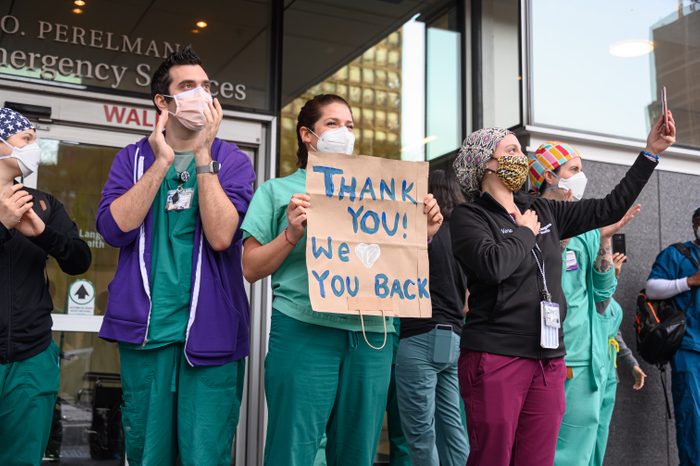
Let’s hear it for nurses!
Nurses often stand first-in-line on those much-talked-about frontlines. Working bedside to distribute medication, check vitals, and they bring patients a feeling of security and levity. These health care workers have an especially crucial task during the novel coronavirus pandemic. To celebrate these hardworking, still-smiling individuals during National Nurses Week, we gathered their stories—their accounts of finding favorable moments in an unfathomable time. Read on for a glimpse behind the scenes of COVID-19, right up to the faces of those in hospitals, fighting to send patients back home.
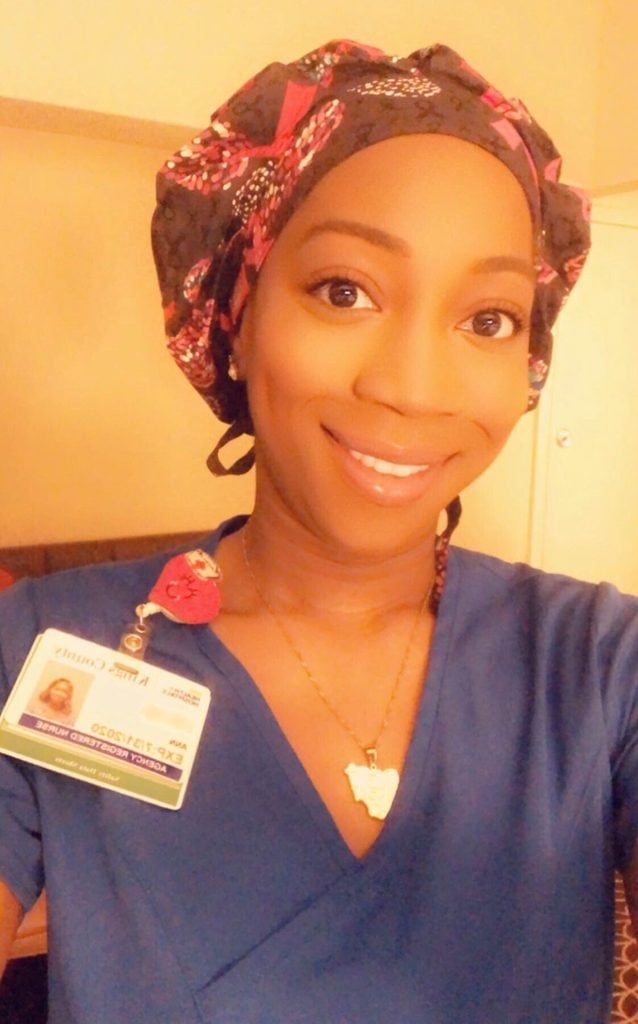
A cheery hello
Ann usually works as a pediatric nurse in Atlanta, Georgia. But when COVID-19 hit New York City, making it the new epicenter of the worldwide pandemic, she packed her suitcase and headed north. “It has been quite a journey, but well worth the sacrifice,” she says. Now that the curve seems to have flattened in the state, she says her Brooklyn hospital is seeing fewer admissions and more discharges. But she’ll always remember one patient.
“I will never forget the first patient in the [intensive care unit] ICU that I saw before he was transferred out of the ICU. He was sitting up in the chair and I went to his bedside and greeted him and told him he looked great. I had a huge smile behind my mask and held back tears of joy because it was a sign of hope seeing him recover and battle such a deadly virus,” Ann says, recalling how the hospital plays music over the loudspeaker each time a patient with COVID-19 gets discharged, another bright light to her long days. “The support from everyone has been overwhelming—from Mayor Bill De Blasio visiting us at the hospital to the New York Police Department and New York Firefighters driving in front of the hospital playing their sirens as a sign of gratitude. The sense of community has been overwhelming and I will never forget during a pandemic, how united we became as human beings.” Find out the 13 celebrities you didn’t know were nurses.
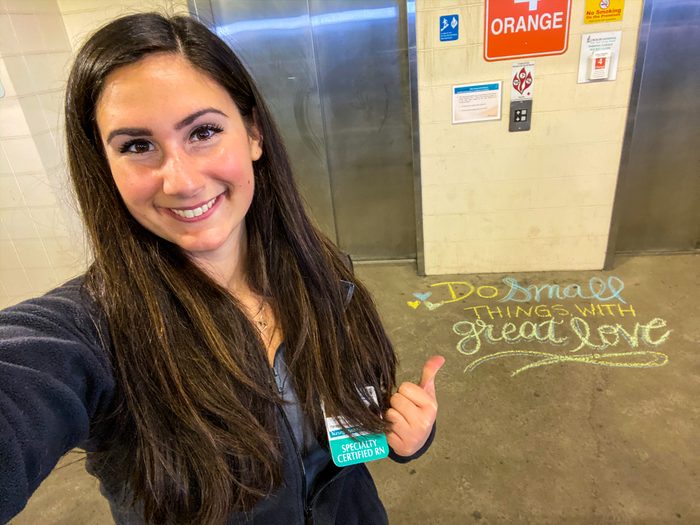
Small things with great love
Ashley Haugstatter at Crouse Health in Syracuse, New York, used to work as a bedside nurse, but now describes herself as a “nurse for the nurses” and a “nurse cheerleader” thanks to her managerial position at the hospital. Because she wasn’t working one-on-one with COVID patients, she knew she had to do something else. “When bad things happen, I’ve found that instead of asking a ‘why’ question and coming up short on answers, you can ask yourself a ‘what’ or ‘how’ question. What can I do to help? What would make someone smile today? How can I bring joy or compassion to others? How can I show up for someone else today?” Haugstatter says. “This is what nurses do all the time—we face many tough situations, and we are always finding small ways to help to make others feel just a bit better during their toughest times.”
During this tough time, Ashley turned her attention to helping nurses themselves and started making chalk drawings in the parking garages at the hospital, spreading messages of hope, positivity, and gratitude on every floor. “I wanted the nurses to know that everyone was thinking of them and that they are brave, strong, and amazing, even if it doesn’t feel like it. It was a small gesture that I hope meant a lot to them. If I could make one tired nurse smile at the end of their shift, then I’d done my job!” she says.
“I was trying to live out one of my favorite quotes: ‘We cannot all do great things. But we can do small things with great love,'” she adds. “That has been my nursing mantra for a long time, and it is what we, as nurses, are great at doing.”
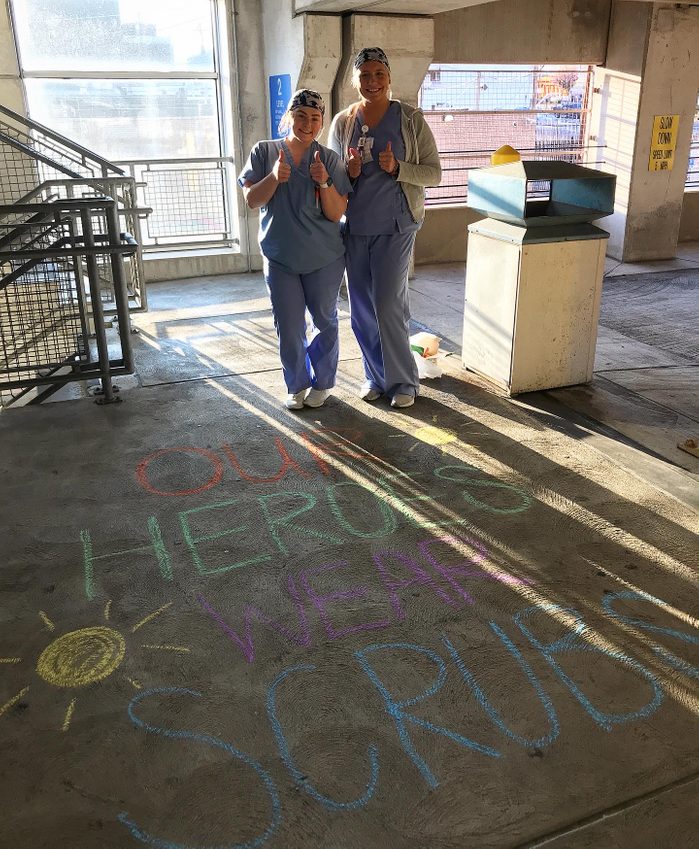
Spreading sunshine
Erin Donohue and Allie Toczylowski typically treat surgical patients or trauma victims of incidents like gunshots or car accidents at the Einstein Medical Center in Philadephia. But right now, they’re taking care of coronavirus patients placed on ventilators. “You’re geared up for your whole shift which is extremely exhausting. And everyone working in our unit is either an ICU nurse picking up overtime shifts to help or nurses from other areas of work, who are forced to learn on the go. It definitely makes for some rough shifts,” Erin says. “I could go on and on about how bad these patients are, but the real focus of our story is this: We found that during this time, people—including ourselves—were very anxious and fearful.” So, Donohue and Toczylowski chose to commit to positivity instead.
“It all started with chalk artwork that we did in the parking garage before one of our shifts. Our work got posted on Facebook by a stranger and we started getting requests to do more,” Erin explains. That’s when they decided to start The Sunshine Committee, posting inspiring notes around the hospital. Then, they received artwork donated to their unit and decided to launch an Instagram page, challenging followers to join them in practicing more positivity. “We initially funded these challenges from our own pockets but recently [we] have received donations from businesses to keep it going,” the women say. “Keeping a positive mindset really gives us the motivation we need to step it up during this rough time. If we can even put a smile on one person’s face, it makes it all worth it.”
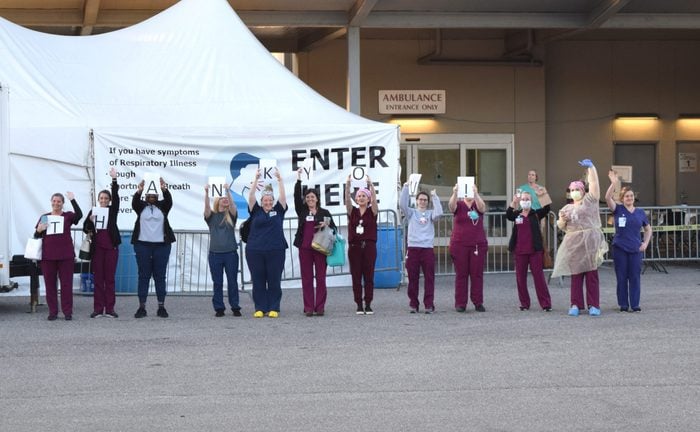
Community support
“After hearing we needed to prepare for the deadliest week to come in this pandemic, we walked outside to find hundreds of friends, family members, and complete strangers showing their support of the hospital staff,” Hayley Trovinger, a nurse manager, emergency room, at Springhill Medical Center in Mobile, Alabama, says of a recent tribute dedicated to her and her co-workers by their neighbors. “They turned up in their cars, lights blinking and holding up posters with positive messages. God sent us this sign—we are going to be OK, because of the support our community has for us. We love you, Mobile!”
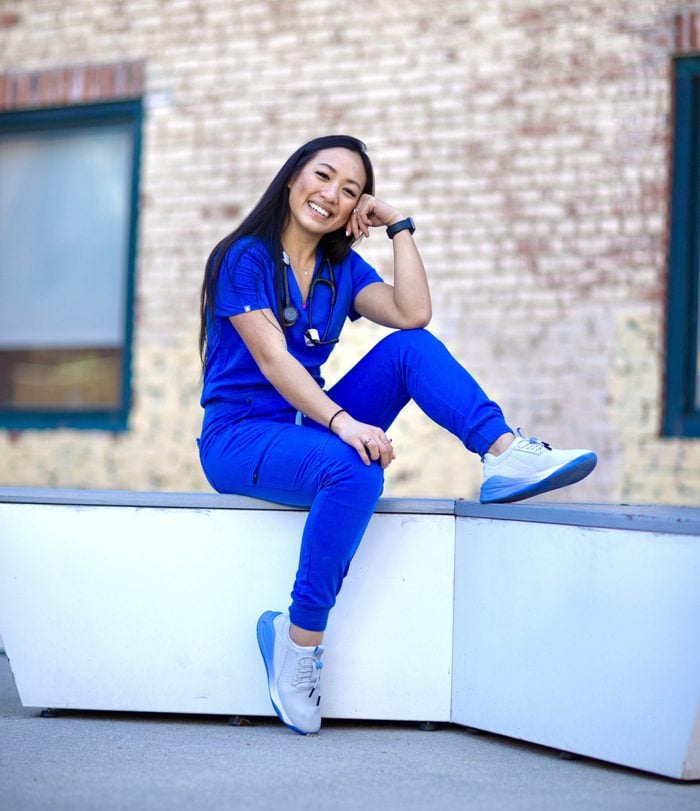
A taste of home
There’s nothing like a home-cooked meal, especially in the hospital. Jasmine Nguyen, gynecology oncology, general medicine, and COVID nurse at Thomas Jefferson University Hospital in Philadelphia remembers a particularly special moment with one of her COVID-19-positive patients. “He is the sweetest 81-year-old pop-pop and although confused at times, extremely kind and grateful for the care he has been given,” she says. The only problem: he hated the hospital food, which decreased his appetite and increased his weakness. So, Nguyen and her teammates brainstormed how to handle it. “As part of the solution, we got approval for his wife and son to cook some homemade meals to send to the hospital for him. As expected, he was in awe of ‘how delicious the hospital food just became!’ He was quite the jokester… I explained to him how someone special made this meal for him. After one bite, he had already known that his son made it—it was a recipe that he had taught his son to make. I was so happy to see him not only finish his meal but feel a sense of security through the food, knowing that his family was doing everything they could to help. I took a video for him to thank his son and let’s just say, I did not have a dry eye.” These stories from emergency room nurses are almost too crazy to be true.
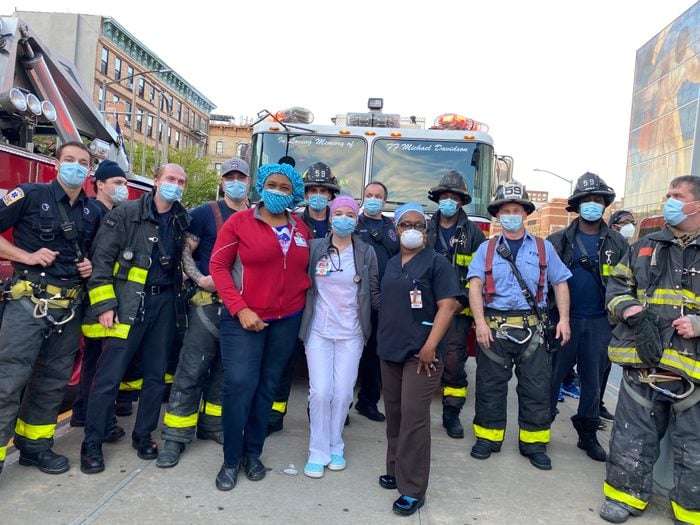
“I love New York!”
“I was born and raised in New York, and the resilience of this city is truly something to admire,” Logan Quesada, a surgical unit nurse in New York City, says proudly stating that New Yorkers always have each other’s backs. She saw that support in full force outside her hospital recently. “To see New Yorkers come together and support us working on the frontlines creates a feeling I can’t begin to describe. Hearing our neighbors clap from their homes at 7 p.m. [every night] always brings tears to my eyes. It’s like the city is right there with us while we’re taking care of their loved ones,” she says. “When the community organized a thank you in front of my hospital, it was so uplifting. To see the firemen, police, and our neighbors outside clapping for us was incredible. I am so proud to be a nurse working in the city I love the most. We got you, NYC!”
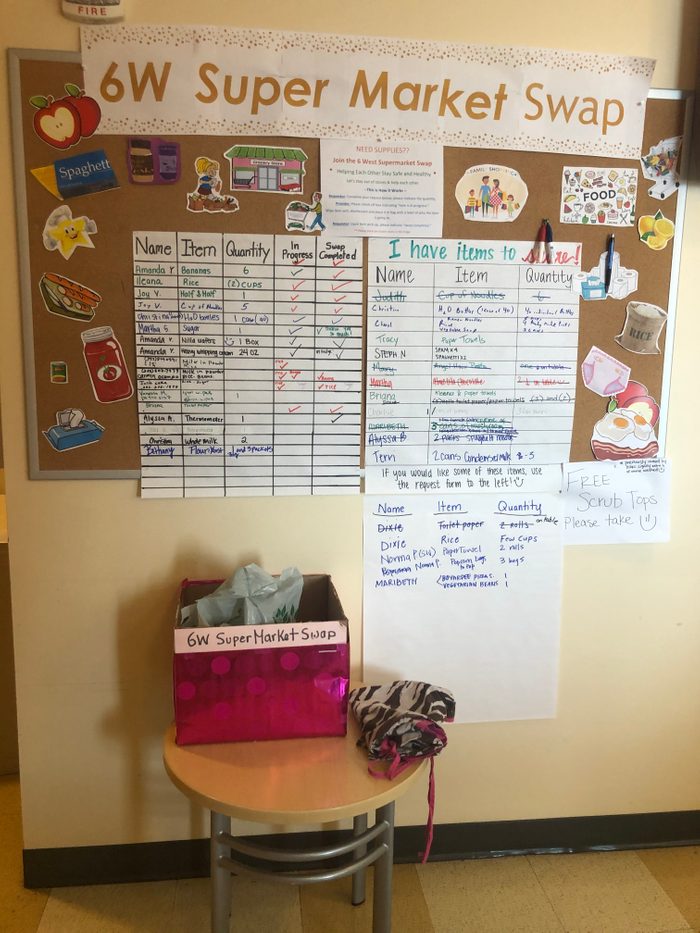
Supermarket swap
Martha Salmon, a pediatric transplant unit nurse in Los Angeles, California, and her colleagues at her hospital decided to help each other out by creating a sort of “supermarket swap,” she says, so that all of them wouldn’t have to go to the grocery store so often. They buy extra items and share with the rest of the staff, or with whoever needs the goods. “We have a huge sign-up board and we say what we need or what we have extra of,” Salmon says, giving examples of toilet paper, water bottles, pasta, sugar, fruits, rice, and snack items as things they’ve swapped. “The leadership team creating the ‘supermarket swap’ really showed how much they care about the staff’s safety and it brought our unit closer together as a whole during these hard times of dealing with COVID-19,” Salmon says.
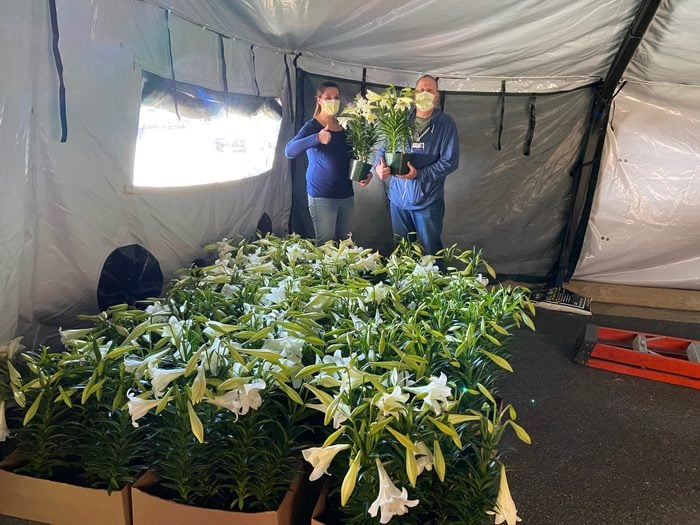
A reminder of spring
“Easter and Passover are a time that many of our staff would traditionally spend gathered with family and friends,” shares Kiersten Henry, director of the American Association of Critical-Care Nurses (AACN) and chief advanced practice clinician at MedStar Montgomery Medical Center in Olney, Maryland. “This year, between COVID stay-at-home restrictions in our state and long hours at the hospital due to the pandemic, many of our staff were working and unable to celebrate in the usual way,” Henry shares. “Dave and Karen Johannes, owners of The Good Earth Garden Market, generously donated 100 Easter lilies to our hospital staff in recognition for their hard work. Regardless of religious affiliation, the lilies provided a symbol of hope for our nurses and associates. They were a beautiful reminder of spring, of hope, and of the constant support from our local community.”
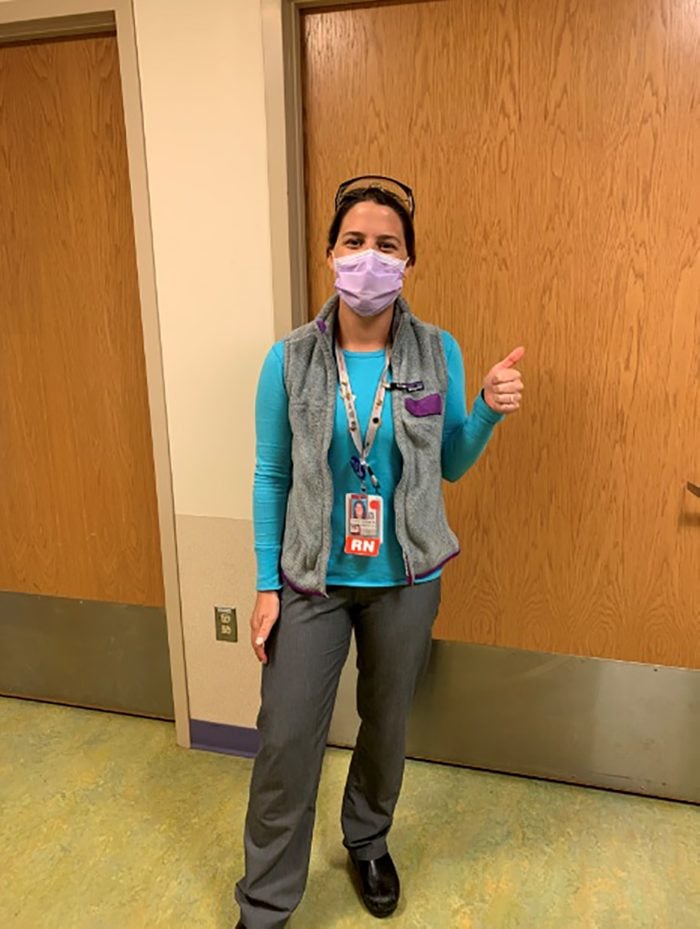
Anything and everything she can do
On March 26, Kimberly Gerland, a critical care nurse at Children’s National Hospital in Washington, D.C., woke up with a scratchy throat and a cough. Thinking it was allergies at first, her symptoms progressed throughout the day and she woke up with a fever the next morning. Two days later, she tested positive for COVID-19. Though her symptoms remained relatively mild, Gerland quarantined in her apartment for 14 days, then tested negative on April 8. She returned to work the next day and soon after, signed up to participate in an antibodies test, and eventually donated plasma, too—both tasks only those who have had COVID can do.
“I want to help people, that’s why I’m a nurse,” says Gerland, who previously worked on an Ebola team. “I felt guilty because I was out at a time that I felt was early…If I wasn’t able to be at the hospital in the beginning, [donating antibodies and plasma] was what I could do to help.” Kim says she’ll continue to donate plasma as much as she can, in hopes she’ll help with research on the virus and an eventual vaccine. Here are 20 things you’re probably doing that nurses wouldn’t.
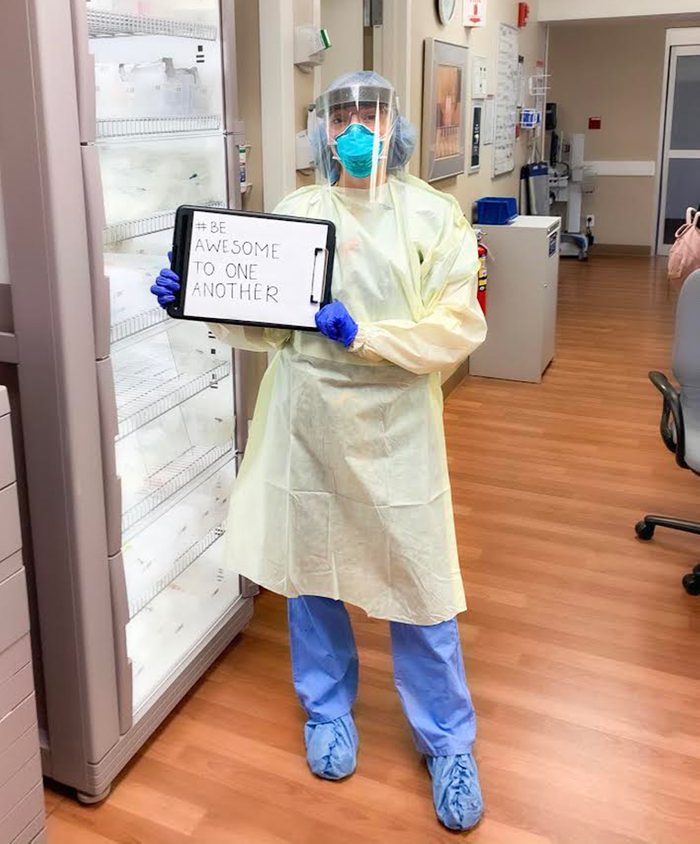
#BeAwesomeToOneAnother
Social media has a way of bringing people together—especially when so many are physically apart. It’s helped nurses like Maddi Ward, a cardiovascular intensive care unit nurse at Honor Health in Pheonix, reach out to their medical communities. Hashtag campaigns, like #BeAwesomeToOneAnother, has united healthcare workers from all over the world. “It was there to help us remind each other that even during tough times, we can be kind and encouraging to those around us,” Ward says.
In addition to her virtual community, Ward thanks her co-workers for serious support, innovation, and care while working the frontlines. “From creating a ‘busy box’ of donated items for patient entertainment to lining the halls and cheering on patients as they recover from COVID-19 to sewing scrubs caps for each other to help keep us protected, we have truly come together as a team,” she says.
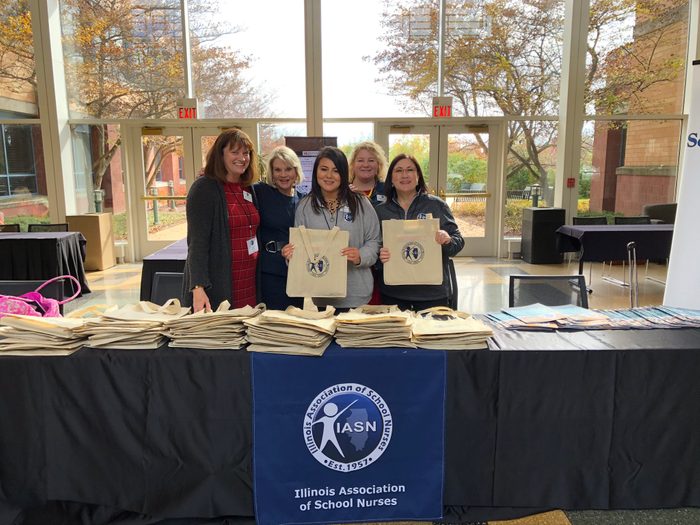
Serving at schools
It’s not just the nurses in hospitals working to help those in need. “School nurses are no longer the hidden health care system in the United States. We were at the frontlines before stay-at-home orders took effect and played a critical role as schools grappled with responding to COVID-19,” says Gloria Barrera, president-elect of the Illinois Association of School Nurses. “We advised district leaders, participated in county emergency discussions, and gave our expert assessment at the state level. On March 11, I was asked to join the Illinois School and Campus Subcommittee of the Governor’s Coronavirus Task Force and served as the representative for school nurses.”
Gloria and other school nurses across the United States have ramped up their efforts to help, too, she says, compiling personal protective equipment, volunteering at meals on wheels, distributing school lunches, and donating blood. “I’ve also called on every school nurse to submit a 60-second video to the #WhyPublicHealthMatters campaign so that we may share how essential school nurses are to the children and communities they serve,” Barrera says.
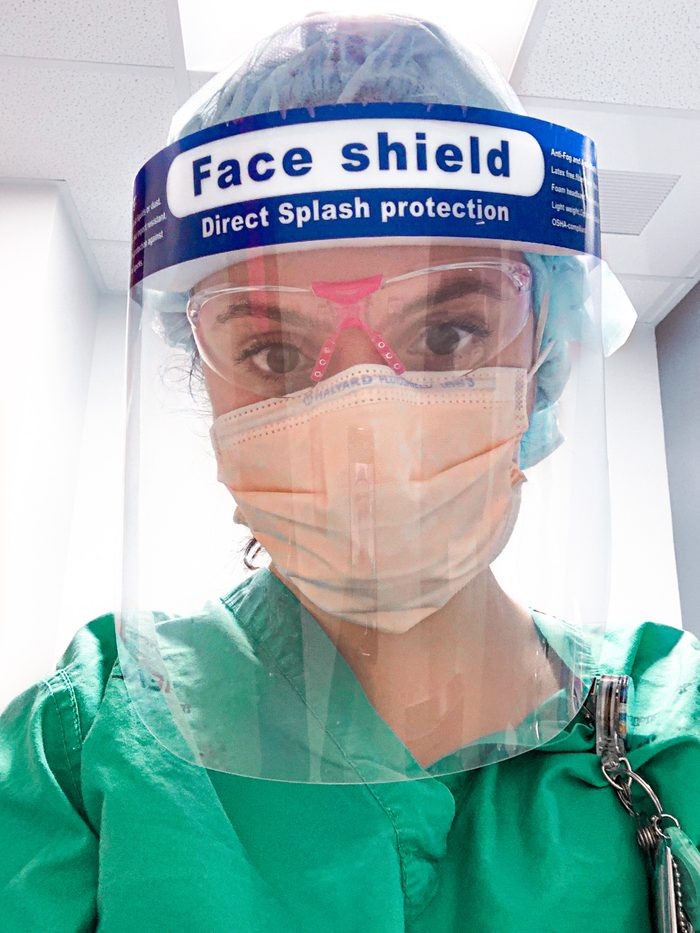
A smile with her eyes
“Hi, I’m Sarah, I’m going to be your nurse tonight!” That’s always been the greeting of Sarah Elizabeth, a COVID unit nurse in Southwest, Florida, to her patients, but it feels a little different these days as she’s decked out in masks, goggles, and a gown. “All of these little things give them anxiety,” she says. “I know they’re scared, and the hardest part is that they’re alone—except when we’re there.” Sarah describes patients trying to talk to their families over the loud sounds of machines nearby and the nervousness patients feel when nurses test their temperature, oxygen level, blood pressure, or heart rate. “Am I going to be OK? Am I going to die?” she hears them asking. “They’ve gone through hospitalizations before, but nothing compares to this—to the weakness they’ve felt, the muscle aches and pains, the chills and sleepless nights.”
Sarah recalls a specific patient who came into the hospital terrified and weak. “They were so sad the first night but each night I laughed with them, told them how good they were doing. When I would check their vitals and see no fever, and their oxygen levels were doing great, I would give them a thumbs up or high five. I’d do little happy dances too and they would smile so big,” she says. “I try to smile with my eyes. I celebrate the big and small wins. I tell them when their vitals look good. I tell them that they seem stronger when they do. I give high-fives and thumbs-up any chance I get, plus a little happy dance here and there.” Here are 50 secrets nurses wish they could tell you.
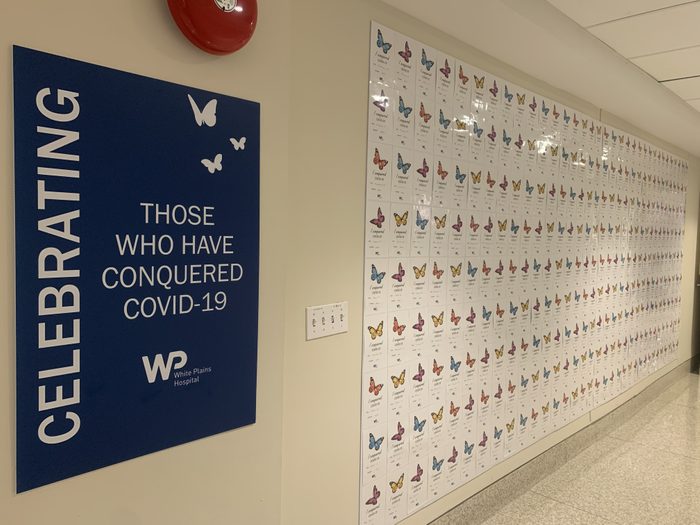
A wall of butterflies
On April 15, White Plains Hospital in White Plains, New York, where Rachel Cappio Davis works, announced that 396 patients with COVID-19 had been discharged home to their families. “Before this, across our hospital, each patient care unit had been celebrating their patient discharges with cheers, photos, and songs. So, to bring it all together, the hospital installed a ‘Wall of Butterflies’ to recognize each of those patients. As more patients are discharged it is regularly updated with new names,” she says. At press time, the wall had more than 600 butterflies.
“It is easy to be hyper-focused on the stress, exhaustion, and heartache that being at the bedside can bring during this unprecedented time, so walking past this massive wall of butterflies is a nice reminder to stop and focus on all the good,” Cappio Davis says. “It is easy to be hard on ourselves—we take on a lot of the emotions felt by not only our patients but their families, being the only connection between people and their loved ones. Having the patient sign their name to a butterfly allows us to not only stop and acknowledge their personal strength battling COVID-19 but gives us the moment to remember that sending someone home to their loved ones makes it all worth it.”
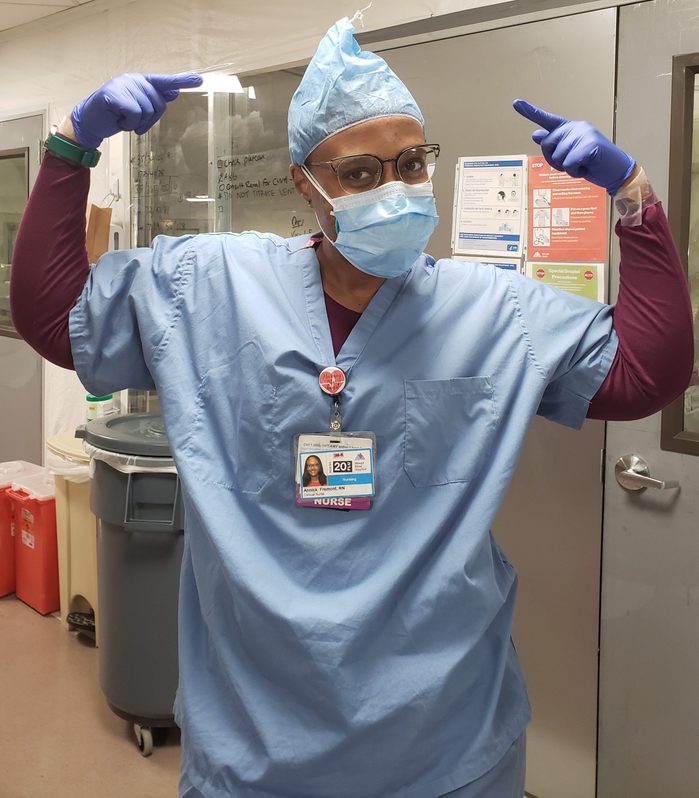
Creative thinking
“In early April, my unit was knee-deep in staffing our hospital’s original COVID-ICU and our MICU,” shares Valerie Burgos-Kneeland, a clinical nurse in the medical intensive care unit (MICU) at The Mount Sinai Hospital in New York City. “After a stretch of working outside the MICU, I returned to take an assignment and found the night nurses wearing shoe covers on their heads because they had used up all their headcovers. Although not part of our standard COVID-19 PPE attire, they repurposed what they had to work with,” Burgos-Kneeland recalls. She says night nurses typically have to get creative out of necessity. “Shoe covers came to the rescue and for a day or two we all looked like blue garden gnomes.” Valerie shares a photo of one of the night nurses, Annick Fremont, rocking the look. “Sometimes something as insignificant as a shoe cover can make a difference,” she says.
